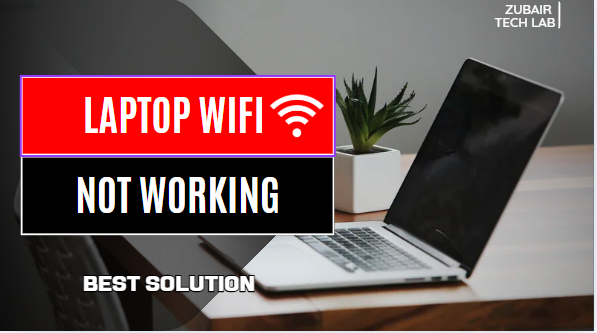1. Introduction
Unexpected laptop WiFi problems can make easy online tasks difficult. Losing your internet connection interferes with enjoyment and productivity whether you’re working, studying, or streaming. One of the most frequent and perplexing situations is when your laptop’s WiFi stops working without warning, or worse, when it stops detecting any networks immediately following a system update.
Small settings changes to more complicated software conflicts are just a few of the causes of these issues. We’ll dissect the most likely causes of these WiFi outages in this guide and offer doable, sequential fixes that you can implement immediately. In order to guarantee a steady and dependable wireless connection, you will also learn how to avoid these problems in the future. By the end, you’ll have the skills necessary to identify and resolve WiFi issues with your laptop without needless worry or expensive repairs.
2. Common Causes of Laptop WiFi Not Working
There are a number of possible causes for your laptop’s WiFi malfunction, some of which are obvious and others of which are not. Hardware problems, like a malfunctioning WiFi card or a loose internal connection, are a common cause. Another common cause is outdated, corrupted, or incompatible network drivers, which can prevent your device from connecting correctly. Your connection may also be lost due to router or modem issues, such as firmware bugs, misconfigured settings, or overheating.

On the software side, network configurations can be abruptly changed by operating system bugs, especially following significant updates. Firewalls and security software occasionally inadvertently block WiFi access, particularly after new rule updates. Environmental elements can also weaken or break the connection, such as physical barriers or signal interference from other devices. Knowing these underlying causes is essential because it speeds up the application of the appropriate solution rather than wasting time on pointless troubleshooting techniques.
3. Why Your Laptop WiFi Not Detecting Any Networks After Update Happens
After a system update, it’s common for a laptop to have WiFi problems, particularly if you notice that it’s not detecting any networks at all. This frequently occurs as a result of network drivers being corrupted, out-of-date, or replaced with incompatible versions while being updated. Additionally, some updates disable features like automatic network detection by resetting or altering the settings on your network adapter.
Software bugs that prevent the operating system from communicating with the WiFi hardware may occasionally be introduced by the update. If security patches alter firewall or antivirus settings, they may also inadvertently prevent wireless connections. Updates occasionally turn off necessary network functions in the background, stopping your device from looking for connections. Restoring network visibility without requiring a complete operating system rollback requires an understanding of these triggers.
4. Quick Fixes for Immediate Connectivity
Attempting a few simple fixes can frequently fix your laptop’s WiFi issue without requiring extensive troubleshooting. To fix short-term issues with hardware or network settings, start by restarting your laptop and WiFi router. The wireless adapter’s signal detection will then be refreshed by turning airplane mode on and off. Make sure WiFi is turned on in your laptop’s network settings. Occasionally, a function key or software toggle may inadvertently turn it off.

You can “forget” the network and reconnect by entering the password again, which will reset the connection data that has been stored, if your laptop is unable to connect even though it can see the network. To get around internal adapter problems, you can also try plugging and unplugging a USB WiFi adapter, if one is available. Many simple connectivity issues can be resolved with these fast fixes, giving you more time before proceeding to more complex troubleshooting techniques.
5. Advanced Solutions for Persistent Problems
You’ll need to look more closely at more complex solutions if quick fixes don’t work. Start by downloading the most recent version of your network drivers from the manufacturer’s website or manually updating them using Device Manager. To restore previous settings, try reverting the driver or uninstalling the problematic update if the issue started after a recent system update.

Command Prompt commands like netsh int ip reset and ipconfig /flushdns can also be used to reset TCP/IP and DNS settings, resolving network configuration issues. Disabling your wireless adapter’s power-saving mode in Device Manager is an additional step to take because it can turn off WiFi to conserve battery life. To check connectivity, temporarily turn off your firewall or antivirus program if you think there may be more serious issues. By addressing both software and configuration problems, these focused steps assist you in reestablishing a reliable, long-lasting WiFi connection.
6. Special Case: Fixing Laptop WiFi Not Detecting Any Networks After Update
After a system update, if your laptop stops detecting networks altogether, focused troubleshooting is usually necessary. Reinstalling the network drivers should be your first step; do not rely on the generic drivers that were installed during the update; instead, get the most recent version from your manufacturer’s website. If that doesn’t work, you can automatically scan and fix misconfigured settings with Windows Network Troubleshooter.
Verify that services like WLAN AutoConfig are operating in the background because updates occasionally disable important network services. If the issue persists, you can temporarily restore connectivity by rolling back the system update, then wait for an official patch before updating once more. If wireless scanning was turned off, advanced users may use a registry change to turn it back on. You can restore network detection on your laptop without replacing hardware or reinstalling the entire system by addressing the underlying causes of post-update problems.
7. Preventing Future WiFi Problems
Future WiFi problems can be avoided by combining preventative maintenance with wise usage practices. To guarantee compatibility with new system patches, first make sure your network drivers are updated on a regular basis. You can do this by using a reliable update tool or by visiting the support page of the laptop manufacturer. Before implementing significant updates, create a system restore point so you can easily roll back in case of connectivity issues.
Avoid stopping updates or abruptly shutting down your laptop whenever you can, as this can corrupt important network files. To lessen signal interference from walls, appliances, or other devices, place your router in an open, central area. Keep your router’s firmware updated and restart it occasionally for added security and stability. Lastly, in case your internal WiFi adapter fails, think about keeping a USB adapter on hand as a backup so you’re never totally offline. By taking these precautions, you can keep your wireless experience steady and trouble-free.
8. Final Thoughts
Although WiFi issues can be annoying, they are much easier to resolve if you know what the underlying causes are. Having a structured troubleshooting approach guarantees that you spend less time speculating, regardless of whether the cause of your laptop’s WiFi malfunction is a simple solution, like switching to airplane mode, or a more complex problem, like driver corruption following an update. You can restore connectivity and prevent recurring frustrations by combining quick fixes, sophisticated solutions, and preventative measures.
If, after updating, your laptop’s WiFi is still unable to detect any networks, keep in mind that this is frequently a driver or settings problem rather than a permanent hardware failure. Your best tools are methodical checks and patience. By using these techniques, you can restore a solid connection, continue to be productive, and deal with similar issues in the future with assurance. It just needs the proper settings to get back online without any issues. Your laptop isn’t broken.
9. FAQs
- Why does my phone connect properly but my laptop’s WiFi isn’t working?
This typically indicates that the hardware, drivers, or settings on your laptop—rather than the router—are the problem. This is frequently resolved by resetting network settings or updating your network drivers. - After updating, how can I resolve my laptop’s WiFi not detecting any networks?
Use the Windows Network Troubleshooter, reinstall your network drivers from the manufacturer’s website, and see if WLAN AutoConfig service is operational. If that doesn’t work, temporarily revert the update. - Can WiFi issues be caused by antivirus software?
Indeed. After updates, security programs can occasionally block network connections. Disabling them for a while can aid in problem diagnosis.
- If my laptop is the only device experiencing WiFi problems, should I reset my router?
You could try, but if everything else functions properly, it’s more likely that your laptop’s network adapter or settings are the issue. - Will changing my WiFi card resolve the problem going forward?
only in the event that hardware failure is the cause. The majority of WiFi issues are software-related and can be resolved without component replacement.
